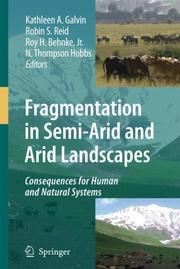| Listing 1 - 2 of 2 |
Sort by
|

ISBN: 9781402049057 9781402049064 Year: 2008 Publisher: Dordrecht : Springer,
Abstract | Keywords | Export | Availability | Bookmark
 Loading...
Loading...Choose an application
- Reference Manager
- EndNote
- RefWorks (Direct export to RefWorks)
Exploring the concept of fragmentation, the ecological processes interrupted by fragmentation, and the social consequences of fragmented landscapes, this book presents a timely synthesis on the effects of fragmentation on arid and semi-arid pastoral systems throughout the world. The global significance of the world's rangelands is large, with these arid and semi-arid systems making up almost 25% of the earth's landscapes - and supporting the livelihoods of more than 20 million people. These ecosystems are also home to several of the planet's remaining megafauna, as well as other important species. Yet fragmentation across these rangelands has significantly impaired the ability of both people and animals to compensate for temporal heterogeneity in vegetation and water by exploiting its spatial heterogeneity, resulting in limited resource availability. The case is developed that while fragmentation arises from different natural, social and economic conditions worldwide it creates similar outcomes for human and natural systems. With information from nine sites around the world the authors examine how fragmentation occurs, the patterns that result, and the consequences of fragmentation for ecosystems and the people who depend on them. The book will provide a valuable reference for students and researchers in rangeland ecology, park and natural resource management, environmental and ecological anthropology, economics and agriculture.
Arid zones --- Semiarid zones --- Pastoralism --- Pastoral society --- ecology --- ecosystems --- Landscape --- comminution --- Biodiversity --- Land use planning --- Natural resources management --- Dryland management --- world
Book
ISBN: 9781402069703 1402069693 9781402069697 9786611875916 1281875910 1402069707 Year: 2008 Publisher: Dordrecht, Netherlands : Paris : Springer ; UNESCO,
Abstract | Keywords | Export | Availability | Bookmark
 Loading...
Loading...Choose an application
- Reference Manager
- EndNote
- RefWorks (Direct export to RefWorks)
Drylands have been cradles to some of the world’s greatest civilizations, and contemporary dryland communities feature rich and unique cultures. Dryland ecosystems support a surprising amount of biodiversity. Desertification, however, is a significant land degradation problem in the arid, semi-arid and dry sub-humid regions of the world. Deterioration of soil and plant cover has adversely affected 70% of the world’s drylands as a result of extended droughts as well as mismanagement of range and cultivated lands. The situation is likely to worsen with high population growth rates and accompanying land-use conflicts. The contributions to The Future of Drylands – an international scientific conference held under the leadership of UNESCO – address these issues and offer practical solutions for combating desertification along with conserving and sustainably managing dryland ecosystems. Major themes include the conservation of dryland biological and cultural diversity and the human dryland interface. This volume documents how our improved understanding of drylands provides insight into the health and future prospects of these precious ecosystems that should help ensure that dryland communities enjoy a sustainable future.
Environment. --- Environment, general. --- Climate Change. --- Environmental Management. --- Landscape Ecology. --- Biodiversity. --- Waste Water Technology / Water Pollution Control / Water Management / Aquatic Pollution. --- Environmental sciences. --- Landscape ecology. --- Climatic changes. --- Environmental management. --- Environmental pollution. --- Sciences de l'environnement --- Biodiversité --- Ecologie du paysage --- Climat --- Environnement --- Changements --- Gestion --- Arid regions -- Congresses. --- Arid regions -- Research -- Congresses. --- Desertification -- Congresses. --- Desertification -- Control -- Congresses. --- Desertification -- Research -- Congresses. --- Deserts -- Congresses. --- Sustainable development -- Congresses. --- Arid regions --- Desertification --- Deserts --- Sustainable development --- Geography --- Earth & Environmental Sciences --- Environmental Sciences --- Physical Geography --- Control --- Research --- Aridization of land --- Desertization --- Arid lands --- Arid zones --- Dry lands --- Dryland regions --- Drylands --- Lands, Arid --- Regions, Arid --- Regions, Semiarid --- Semi-arid regions --- Semi-arid zones --- Semiarid regions --- Sub-humid lands --- Zones, Arid --- Physical geography. --- Climate change. --- Physical Geography. --- Climatology --- Extreme environments --- Landforms --- Biological diversification --- Biological diversity --- Biotic diversity --- Diversification, Biological --- Diversity, Biological --- Biology --- Biocomplexity --- Ecological heterogeneity --- Numbers of species --- Ecology --- Changes, Climatic --- Changes in climate --- Climate change --- Climate change science --- Climate changes --- Climate variations --- Climatic change --- Climatic changes --- Climatic fluctuations --- Climatic variations --- Global climate changes --- Global climatic changes --- Climate change mitigation --- Teleconnections (Climatology) --- Environmental science --- Science --- Environmental stewardship --- Stewardship, Environmental --- Environmental sciences --- Management --- Environmental aspects --- Global environmental change --- Balance of nature --- Bionomics --- Ecological processes --- Ecological science --- Ecological sciences --- Environment --- Environmental biology --- Oecology --- Population biology
| Listing 1 - 2 of 2 |
Sort by
|

 Search
Search Feedback
Feedback About UniCat
About UniCat  Help
Help News
News